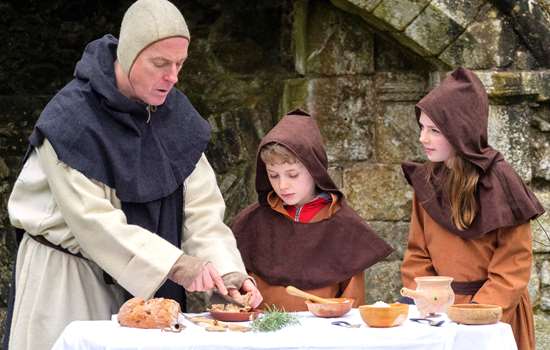Vows and vegetables
Becoming a monk or a nun was a commitment for life – and it wasn’t an easy one! They all took some vows, which shaped the way they lived:
- Poverty – to live with no possessions
- Chastity – to not have any children
- Obedience – to follow the rules
- Stability – to be reliable, for example not leaving the monastery
Monks and nuns spent a lot of time praying and reading, but what isn’t so well known is that they spent a lot of time (up to five hours a day!) working in their gardens.
Crops or contemplation?
The gardens at medieval monasteries were an important part of daily life for monks and nuns. They were not only used to grow fruit, vegetables and herbs for making medicines, but also as places to exercise and spend time thinking, reading and praying. Different orders of monks did different things with their gardens. For example, Carthusians living at Mount Grace Priory, who were hermits (men who lived their whole lives alone), had individual houses called cells with private gardens, whereas Cluniac monks at Castle Acre shared a communal garden.
There isn’t much evidence of monks' and nuns’ gardens, but at Mount Grace Priory, we can see that the layout of each garden changed according to the preferences of the monk it belonged to – a bit like when we choose our favourite plants and objects to put into our gardens today. The gardens were designed using geometric shapes, with different areas for different plants. These included a mix of herbs – some for making medicine, and some for cooking – as well as flowering plants to help create a tranquil space.
Monastic herbs
Gardens and particular types of plants had special religious symbolism (meanings) to monks and nuns. Lots of herbs have religious names or beliefs linked to them, but they were also grown to be useful. Here are some favourite monastic herbs that you could grow in your own mini herb garden:
SAGE (Salvia officinalis)
Medieval people used sage to treat different illnesses. It was also chewed to whiten people’s teeth, and used in cooking, like we still do today! The second part of its Latin name, ‘officinalis’, comes from the name of the officina, the special monastery storeroom where herbs and medicines were kept.
HYSSOP (Hysoppus officinalis)
Medieval people used oil, wine or syrup mixed with the herb Hyssop to treat colds and coughs. They also rubbed it on bruises to help soothe them. Hyssop has lots of blue, pink, or red flowers, which attract honey-bees and other pollinators.
ROSEMARY (Rosmarinus officinalis)
This popular supermarket herb has a mythological story. Ancient Egyptians, Romans and Greeks believed that the Virgin Mary spread her blue cloak over a white-blossomed rosemary bush, and turned the flowers blue. That’s why we call it Rosemary: the ‘Rose of Mary’. Monks used this herb to help with digestion, and also to treat arthritis, sore skin and even baldness!
CHAMOMILE (Chamaemelum nobile)
Chamomile, mixed with other herbs, was used as a medieval cure for poison. Even today, Chamomile tea is still very popular and it is said to be relaxing to drink and to help with digestion. It’s got lots of little white flowers which look and smell great in a herb garden.
Over to you...
Now it's your turn to have a go at growing your own mini monastic herb garden! You could use the monastic herbs listed on this page, or make up your own combination.
Here are some mixtures of herbs you might like to try:
- Herbs for cooking with: basil, thyme, rosemary and chives
- Herbs to attract bees: lavender, hyssop, thyme and rosemary
- Scented herbs: lavender, rosemary, chamomile and basil
How to plant your own mini monastic herb garden
You will need:
- Some herb plants
- A large planter, window box or a pot
- Compost
- A trowel
- Watering can
- Plant labels or lolly sticks
- Marker pen or pencil
-

Step 1
Fill the bottom of your large pot or container with compost, leaving enough space at the top to fit the height of the pots your herbs are in.
-

Step 2
Carefully take your first herb plant out of its pot, and place it into the container.
-

Step 3
Add compost around it and pat it down gently. Repeat this for your other herbs to fill up the container - and make sure to fill up any gaps with more compost.
-

Step 4
Place your herbs somewhere sunny to grow – ask an adult to help you if the pot is heavy! Water the plants carefully, until you can see water start to dribble out of the bottom of the pot. Make sure to check every day and water again if the compost feels dry.
-

Step 5
Write on the labels or lolly sticks using a permanent marker or pencil to create some labels for your plants, and stick these into the container next to each one. Now you can stand back and admire your mini monastic herb garden!




